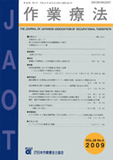Japanese
English
- 販売していません
- Abstract 文献概要
- 1ページ目 Look Inside
- 参考文献 Reference
- サイト内被引用 Cited by
要旨:高齢者の生活機能維持のために筋力トレーニングは有効な方法の一つである.地域での運動教室ではその効果指標としての筋力測定に握力などが利用されることが多い.しかし,生活を営むという観点からは下肢筋力を評価することが必要である.
本研究では,地域在住高齢女性235人を対象に股関節屈曲・伸展,膝関節屈曲・伸展,足関節背屈の筋力測定を試み,加齢変化を検討して年代別評価基準を作成した.筋力は加齢とともにいずれの部位も有意に低下し,個人差が増大する傾向がみられた.加齢による筋力低下率は股関節伸展が最も大きかった.年代別筋力評価基準は,地域での健康づくり運動教室などにおいて活用することが期待できる.
Reports describing community and/or home-based exercise programs for older adults are increasing recently. In field-based research, hand-held dynamometers (HHD) and functional performance tests are often used as indices of muscle strength. Compared to other common strength tests such as isokinetic dynamometry, this method is simple, economic and easy to perform on older adults. Few reports are available to describe the normative values for muscle strength as measured by HHD. However, those reports have been diminished by factors such as age range, the specific test procedures and gender differences. The purpose of this study was to examine differences in maximum voluntary isometric force of the lower extremity using HHD in Japanese community- dwelling older women. 235 older women participated in this study. The subjects' mean age was 72.4 years (SD = 6.9 years, range = 60-89 years). Five lower-extremity movements (hip flexion, hip extension, knee flexion, knee extension, and ankle dorsiflexion) were measured by one experienced tester using HHD. Data for isometric muscular strength was averaged for both legs. A ratio of maximal muscular strength to body weight (STR/WT) was calculated by dividing the muscular strength (N) by body weight (kg). The measurements were found to be reliable. The results of our study reveal that all motions of STR/WT decline significantly with each decade of age (p<0.05), and show great differences of muscular strength between individuals with age. Reference values generated are expressed in STR/WT by each decade of age. These variables were used as normative values for the force of each muscle action. The reference values provided in this study may be useful for clinicians who follow the described testing protocol in Japanese community-dwelling older women. These results provide a basis for the development of resistance training programs for Japanese community-dwelling older women.

Copyright © 2009, Japanese Association of Occupational Therapists. All rights reserved.


